
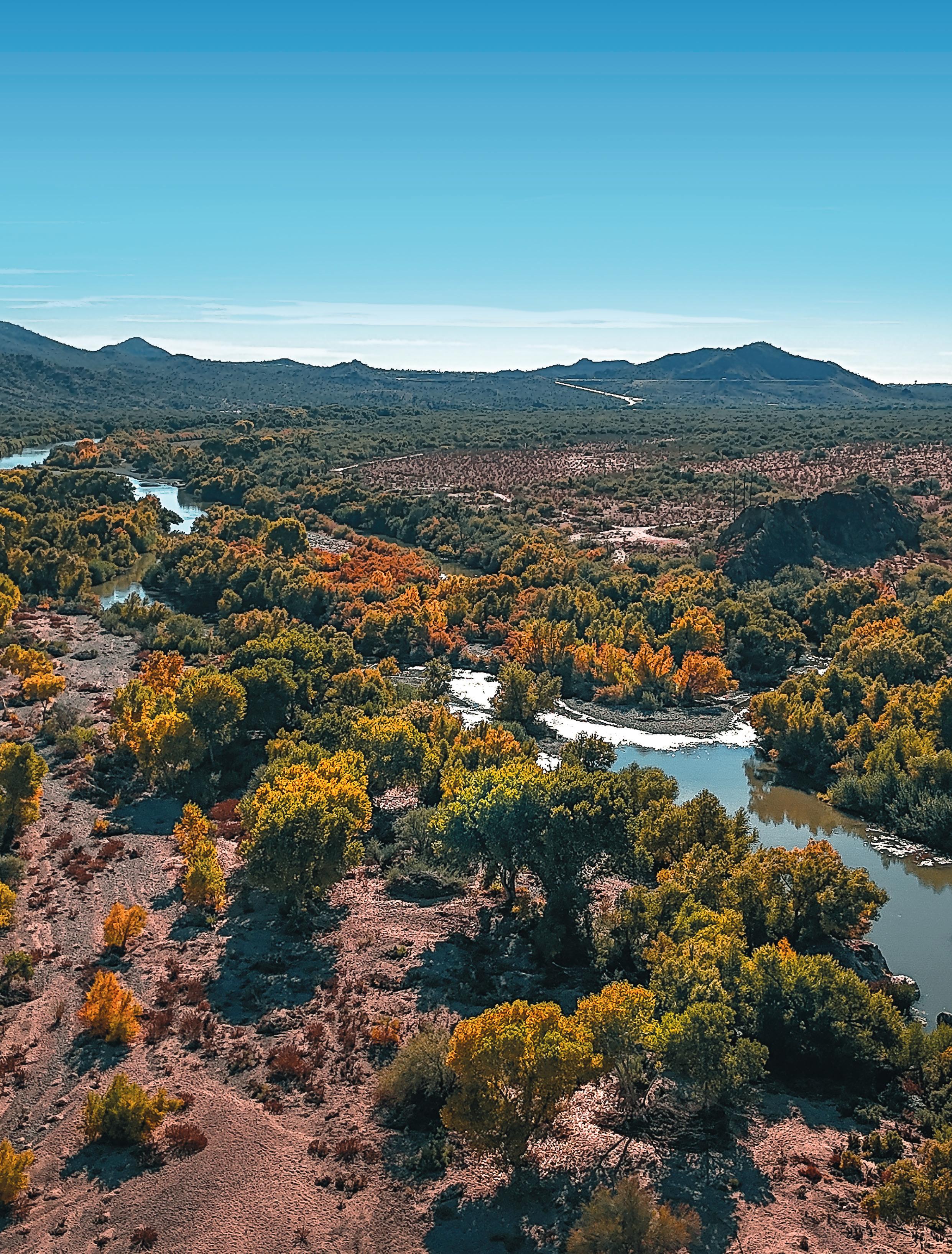
FINDING FORESTS IN NEED
THE STORY BEHIND LOCATING WHERE TREES ARE NEEDED MOST
MAY/JUNE 2024 • ARBORDAY.ORG

AS I TALK WITH PEOPLE about the importance of tree planting and the benefits they provide, I’m often asked how the Arbor Day Foundation decides where to focus our efforts. The short answer is that we plant trees where they will have the greatest impact on people and the planet.
But precisely how we do that deserves a longer explanation. The Arbor Day Foundation relies on science, data, and technology to help guide our decisions — whether in communities or forests, at home or abroad. It’s important we get it right, as each year the planet loses nearly 24 million acres of forest to human actions, drought, and wildfires. That equates to losing forestland roughly the size of the state of Indiana each year. It’s paramount that we concentrate as much of our reforestation efforts using a scientific approach that helps us get trees to forests where they can do the most good.
In reforestation work, we prioritize projects based on a collection of data measuring a variety of important factors that help guide where we direct our efforts. These include the potential impact on climate change, the development of critical habitat for endangered or threatened species, and even how new trees would affect the people living in the area.
The feature story in this issue goes into more detail about how we use science and data to help prioritize our work and highlights a project in the Southwest that is considered what we call a “forest of greatest need.” I hope you enjoy seeing this work in action.
By focusing our efforts this way, we are creating change. Each tree we put in the ground is planted because it is critical to the future of our planet.
This work is only possible because of dedicated members and supporters like you. Together, we are planting a greener, healthier world for generations to come.
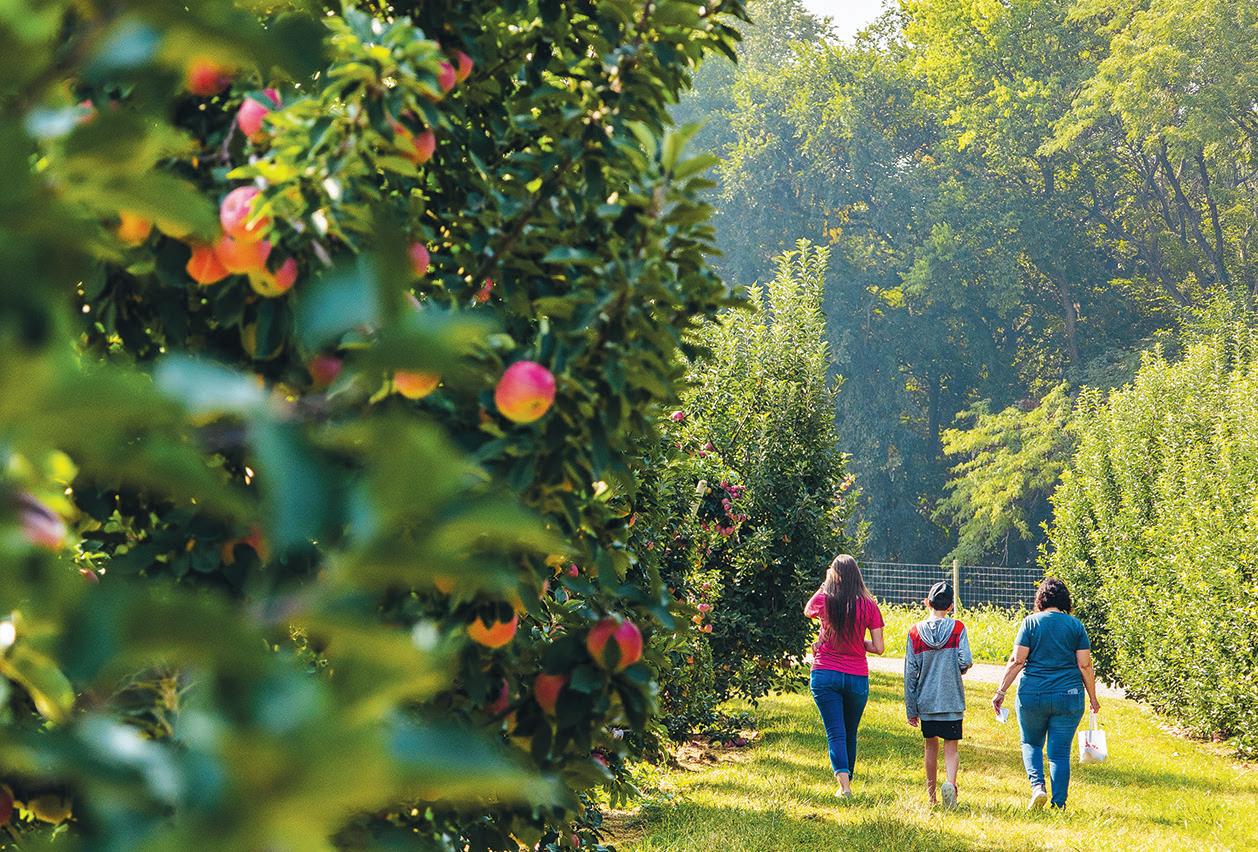
Prepare to Be Smitten
Arbor Day Farm chosen as part of an exclusive group of growers for new apple cultivar
A CAPTIVATING NEW APPLE VARIETY has been added to the orchards of Arbor Day Farm. Introduced to the United States in 2011, the Smitten® apple tree is grown exclusively by progressive, multi-generational family growers. Arbor Day Farm now enters these ranks as one of only five noncommercial growers worldwide.
“We are honored to be one of the select few chosen to grow and share these apples,” said Ben Heusinkvelt, grounds and orchard manager at Arbor Day Farm. “It’s exciting to be a part of this elite group of growers and contribute to the orchard industry progress both nationally and locally. We’re the only orchard in a 500 mile radius that is able to offer this apple variety.”
This spring, 100 Smitten apple trees were planted at the farm. In as little as three to four years, the trees will be producing a bumper crop of sweet, crisp apples that visitors can pick right off the tree.
Looking to produce apples in your own backyard? Ben has shared tips for getting started — everything from choosing the right varieties to dealing with pesky pests. Check it out at arborday.org/ backyardorchard and get planning today!
This new cultivar is the latest chapter in a long legacy of dedication to apple trees. It represents the next generation of a timehonored fruit and pairs nicely with the antique varieties featured in Arbor Day Farm’s Preservation Orchard.
the cover: The
found along the
is just one example of an area in need of
This tree canopy provides important
while protecting one of
primary water
2 ARBOR DAY • May/June 2024 • 888-448-7337 • arborday.org FOLLOW US AT facebook.com/arborday
On
riparian forest
Salt River
restoration.
wildlife habitat
Arizona’s
sources.
JOURNAL ARBOR DAY FOUNDATION CHIEF EXECUTIVE, Dan Lambe
ARBOR DAY
Too Cool at School
Tree planting helps curb rising temps at three Arizona schools.
ARE TREES TOO COOL FOR SCHOOL? Absolutely not. Yet the “cool factor” is exactly what they’re bringing to some schools in Tempe, Arizona, a city that continues to feel the heat.
“Last summer, we saw a lot of record breaking with consecutive days above 110 degrees. And overall, the health of the people within the valley is suffering. It really is an epidemic,” said Ali Guttenberg, planting programs manager with Trees Matter, an Arizona-based partner working to build a culture of tree advocates in the Valley of the Sun.
As the city faces rising temps, it only makes sense to turn to trees as a solution for schools. Shade from strategically planted trees can cool concrete schoolyards by as much as 10 degrees, creating a better environment for children to learn and play outdoors.
Thanks to a partnership between the Arbor Day Foundation, Trees Matter, Arizona State University, the City of Tempe, and local school districts, 45 trees were planted on school grounds in three communities with high daytime temperatures and low tree canopy.
Becoming a HeatReady School
These newly planted trees are a critical step in mitigating rising schoolyard temperatures. They are also the first step for these schools to become HeatReady Schools — a program developed by Arizona State University’s Global Institute of Sustainability and Innovation. This initiative includes a scorecard with 30 recommendations that support heat safety.
Each of these Tempe schools will continue to work with local partners to improve their “cool school” status with the help of the HeatReady scorecard.
A focus on learning
It only makes sense for education to play an important role in planting projects at schools. The
Wish your community schools were cooler?
community members, students, parents, and teachers who volunteered that day received training from the city’s urban forester. This was important even beyond the planting event.
“I feel like everyone left wanting to plant a tree in their own yard,” Ali noted.
Additionally, school maintenance staff received training to ensure they were well-equipped to help these trees thrive. Curriculum is also being developed to help students learn more about the benefits of trees.

Trees can go a long way in protecting children from rising temperatures on school grounds. Sometimes, all it takes is a dedicated advocate to get a planting project going. Talk to your school district about the potential for upping its “cool” factor through trees.

ARBOR DAY • May/June 2024 • 888-448-7337 • arborday.org 3 FOLLOW US AT instagram.com/arbordayfoundation


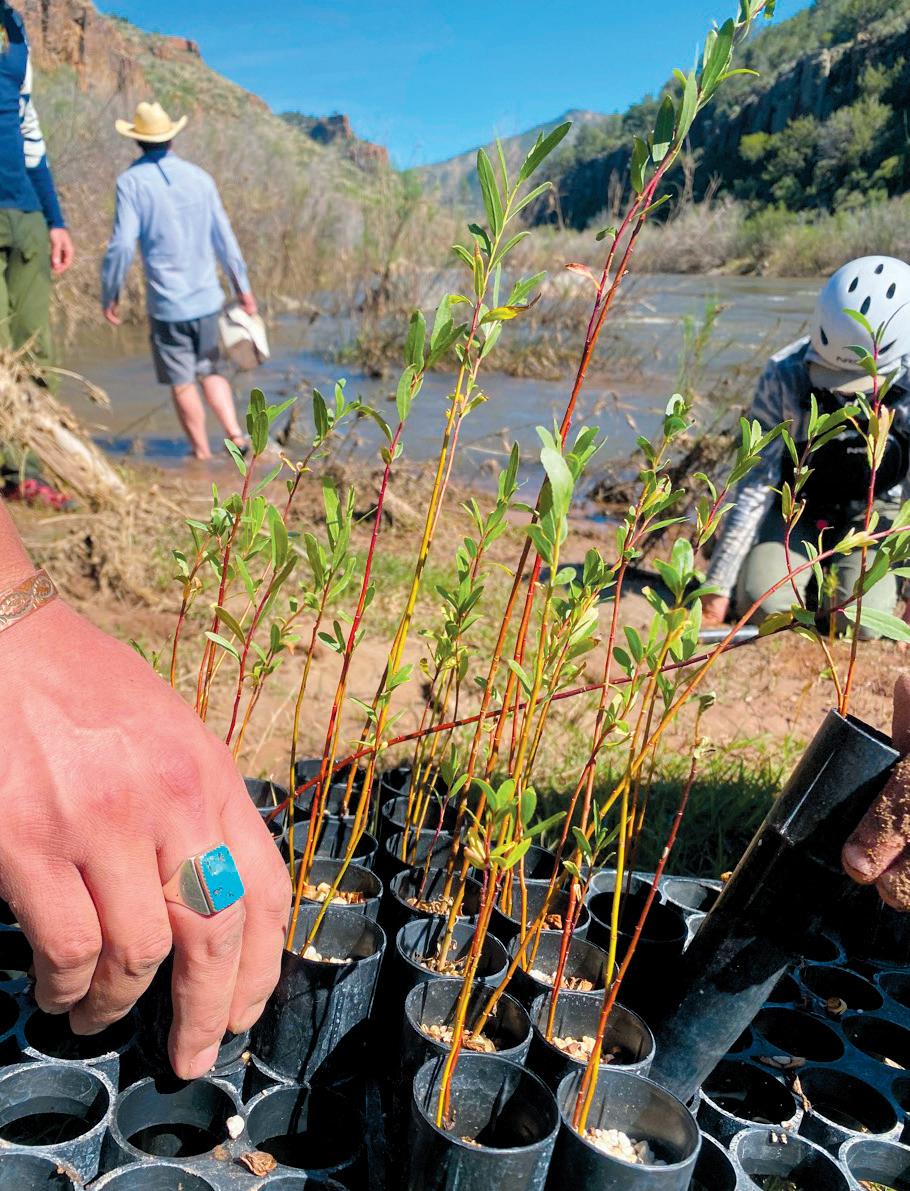
Top: Volunteers gather to replant riparian corridors along the Salt River.
Middle: Newly planted trees will grow to provide habitat for wildlife and help keep the waterway clean.
Bottom: Trees are sourced from a local nursery run by the White Mountain Apache Tribe.
What Does It Take to Plant Trees for the Greatest Impact?
Hint: It’s a lot more than pinpoints on a map.
Each year, the world loses more than 24 million acres of forest cover. That’s a void roughly the size of Indiana — a void the Arbor Day Foundation is working with members, supporters, and partners to restore. And it’s no small job.
To ensure tree planting is focused in areas that will do the most good, we have developed a guide using science and data to help identify forests of greatest need. These are forests that need trees now to ensure they can support biodiversity, climate, and people.
Planting Backed by Science
This science-based approach is a formula that layers many data points, including how the region’s reforestation will impact climate change, wildlife, and even Indigenous lands. It also takes into account where the Arbor Day Foundation has verified and trusted planting partners in our global network with shovels in hand, ready to plant.
“This approach is helping us direct our efforts to where we can have the greatest impact,” said Bradley Brandt, manager of forest restoration for the Arbor Day Foundation. “Science and data have become critical components of our decision-making process, and it’s ensuring each of the trees we put in the ground do more for the planet.”
Why a Science-Based Approach Matters
The Arbor Day Foundation is dedicated to leaning on data to help us identify priority areas for planting because:
• It’s a well-rounded method that considers the many benefits of trees, including wildlife habitat, carbon capture, clean water, and more.
• It places a high value on people, accounting for how trees would affect those living in a particular area.
• It makes us good stewards of supporters’ funding, helping to invest donations in the most effective projects.
Find out more at arborday.org/science
4 ARBOR DAY • May/June 2024 • 888-448-7337 • arborday.org
Through the process, the Foundation has identified five priority planting regions to focus our efforts in: the American Pacific West, the American Southeast, the Atlantic Rainforest, the Amazon River Basin, and Central America and the Caribbean.
Not all of our reforestation work takes place in areas identified as priorities, but this approach ensures that the work we do is intentional — that it has the biggest impact possible as quickly as possible. Even outside the five global priority regions, we give each of the forests we work in a score of 1–10 to help us classify the need of every forest we plant in and to be the best stewards of our partners’ and members’ support now and in the future.
High-Priority Work in the Southwest
One great example of tree planting in forests of greatest need is unfolding in Arizona with an experienced partner that has planted more than 8 million trees since 2011. The Arbor Day Foundation and Ecoculture are working to reestablish forestland lost to wildfire and restore important riparian tree cover that has become degraded.
Trees for Wildlife
Newly planted trees are helping forests heal and providing important habitat for wildlife. One animal relying on this new tree cover is the Mexican gray wolf. Native to Arizona and New Mexico, this subspecies of wolf was considered extinct in the wild in the 1970s. Wolves were rereleased in the area in 1998 thanks to the dedication of the U.S. Fish and Wildlife Service, and the restored forest stands will provide cover and habitat necessary to help this struggling population thrive.

Other species benefitting from the trees include endangered southwestern willow flycatchers, threatened western yellow-billed cuckoos, bald eagles, mountain lions, and black bears.
Forests for People
In this arid part of the country, ecosystems can be more fragile.
“Large wildfires can result in loss of overstory trees for multiple decades to centuries,” said Kevin Grady, director of Ecoculture and faculty member at Northern Arizona University.
That loss has significant long-term impacts on climate change as well as area wildlife and communities relying on the forests.
“Without trees and their organic inputs to the soil, post-fire areas are sources of CO² to the atmosphere for decades. Water from springs that are fed by the slow release of snowmelt and rain is no longer a reliable source of water for communities,” he said.
Thanks to our dedicated donors and members, trees were planted this past year to help restore the land and support the people who call this region home.
As you know, reforestation is about people just as much as wildlife. With much of this planting happening on tribal lands, our work with Ecoculture is happening in partnership with the local Indigenous community. The trees were grown by a nursery run by the White Mountain Apache Tribe. Purchasing trees through this nursery has helped the operation to grow — their capacity has expanded to 200,000 trees — and boosted the local economy.
Community members were also involved in the hands-on planting efforts, creating a meaningful connection between local residents and the reforestation efforts happening on their land. And this work will provide a wide range of benefits to people for generations to come, including a life-sustaining water source for communities in an arid region.
Planting a Better Future
This Arizona planting is a wonderful example of creating greater impact through a science- and data-driven approach to reforestation. Habitat for endangered species. Clean water for local residents. Involvement from the people who live there. The change is real, and the future is greener.
See more examples of this approach in action at arborday.org/examples
ARBOR DAY • May/June 2024 • 888-448-7337 • arborday.org 5
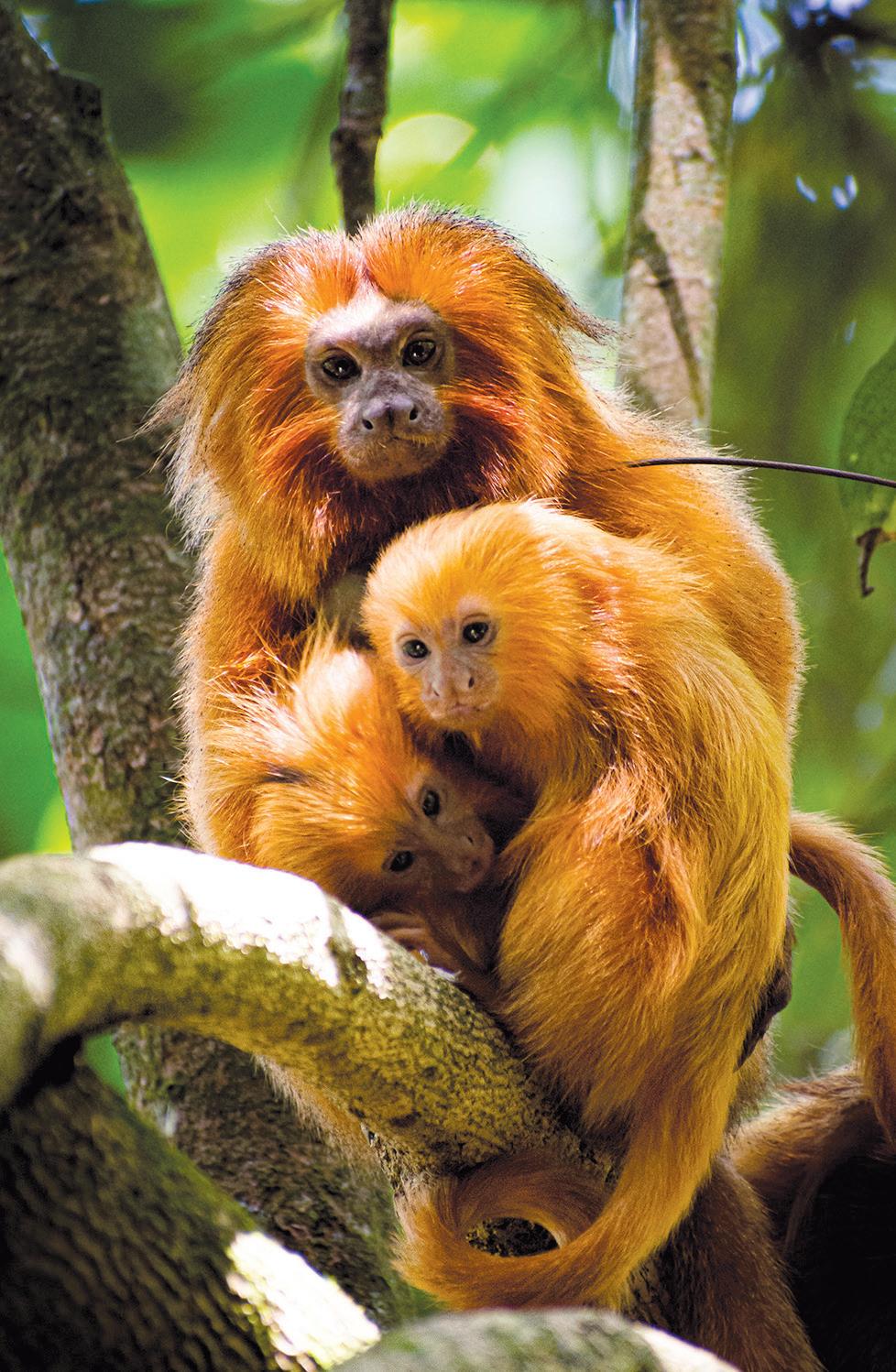
Restoring One of Brazil’s Magnificent Biomes
IT MAY BE LACKING IN NAME RECOGNITION, but one could argue that this rainforest is more important than its more widely known counterpart.
The Atlantic Forest stretches along the eastern coast of Brazil. While not as far-reaching as the Amazon, this rainforest is a critical component of the country’s landscape.. Unfortunately, its tree canopy has diminished greatly — only 20% of the area remains shaded by healthy tree canopy. Even more dire is the 400 species of animals and 200 species of plants native to the Atlantic Forest that are threatened, relying on the forest for survival.
The Arbor Day Foundation is working with onthe-ground partners throughout Brazil to address this

The work in the Atlantic Forest is part of a larger initiative at the Arbor Day Foundation to focus reforestation efforts in forests of greatest need. Visit arborday.org/regions to learn more about our approach to international reforestation.
crisis and restore the precious rainforest ecosystem. With the help of dedicated members, supporters, and corporate partners like Salesforce, trees have been planted in six different areas of the rainforest.
Atlantic Forest restoration is helping to change not only the landscape but also the future of Brazil. The newly planted trees will grow to provide much-needed shelter for species on the brink of extinction. And they will help to provide a cleaner source of drinking water for people living in and around São Paulo.
This is the kind of impact that is possible when members, donors, and corporate supporters join together to drive change.
Leaving a Legacy May Be Easier Than You Think
TREES THRIVE FOR GENERATIONS, and so can your support of the Arbor Day Foundation when you establish a charitable gift annuity. As you receive consistent retirement income, your gift will leave a legacy for years to come.
Charitable gift annuities offer retirement income with a large portion of it tax-free. For example, Patricia, age 84, made a $75,000
donation to the Arbor Day Foundation for a charitable gift annuity. She receives $6,675 (8.9%) annually, with $5,193 of it tax-free. And at tax time, she can take a $39,183 charitable deduction that can be spread over several years if necessary.
According to the SECURE Act 2.0, individuals over 70½ can make a one-time $53,000.00 Qualified Charitable Distribution (QCD) from an IRA account to a charitable gift annuity. This distribution will count toward the donor’s required minimum distribution for the year and will not be recognized as ordinary income for tax purposes. Rather, taxes will be spread out and paid on the individual gift annuity payments.
To receive additional information about charitable gift annuities, please mail in the coupon, call Erin Mousel at 888-448-7337, ext. 9614, or email giftplanning@arborday.org.

LEARN
Mail to: Arbor Day Foundation 211 N. 12th St. • Lincoln, NE 68508 Please provide me with a confidential quote for an Arbor Day Foundation Charitable Gift Annuity. Birth Date / / I am considering a gift annuity of $ ($10,000 minimum) Name Address City/State/Zip Telephone ( ) Best time to call Email
MORE. NO OBLIGATION.
08917 100

TREE BASICS
Trees: The Natural Mood Boosters
Time spent in nature can improve your mental health
SOME SAY laughter is the best medicine. But according to recent findings, the best medicine for your mental health might just be trees. Over the years, a growing body of research has proven that regular access to trees makes us happier and healthier.
In honor of Mental Health Awareness Month in May, we’d like to share with you just a few of the ways trees can support your mental well-being.
• Spending time in nature reduces levels of a stress hormone called cortisol. It also lowers blood pressure.
• Living within 100 meters (about 300 feet) of a tree can reduce rates of depression.
Spotlight on Tree Campus Healthcare

• Being among the trees (or even climbing them!) enhances cognitive functions such as learning, thinking, and reasoning.
• Walking through green space with trees can improve memory and attention span.
This month — or any month — make a conscious effort to get out and enjoy the trees around you, whether that’s in your own yard or in a community space. And feel the mood-boosting benefits of nature.
Healthcare facilities across the country are stepping up to improve the tree canopy — and overall wellness of residents — in the communities they serve. The Arbor Day Foundation’s Tree Campus Healthcare program was designed to recognize this dedication.
Is there a hospital, assisted living center, or other healthcare facility in your community that’s going above and beyond for trees? Tell them to apply for recognition! Find out more about the specifics at arborday.org/healthcare
How Will Climate Change Affect Your Hardiness Zone?
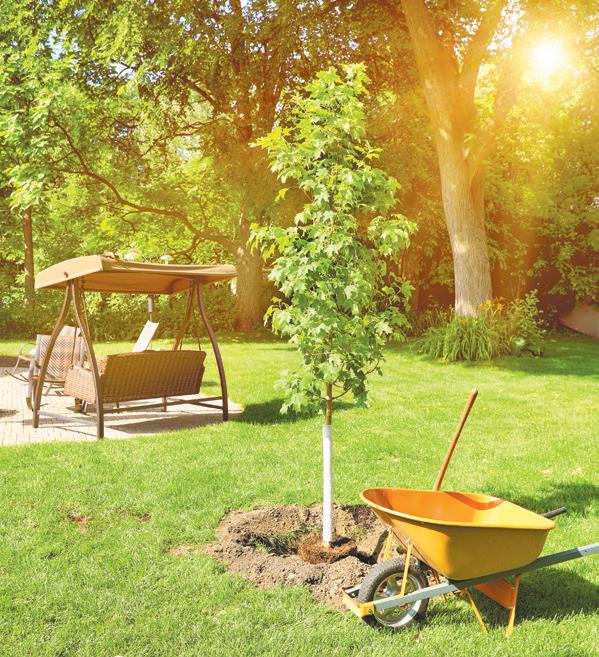
AS THE SHIFTS IN OUR CLIMATE bring about warmer summer temps and more severe storms, another shift is also happening — the shift in hardiness zones.
To help you understand how this could affect the region you live in, the Arbor Day Foundation partnered with The Davey Institute to create an interactive tool that illustrates how the future hardiness zone map could look by the middle and end of the century. This tool can prove valuable as you plan future planting projects. Knowing what your hardiness zone may be in a few decades can guide your tree choices and ensure a landscape that will stand the test of time.
Start exploring today at arborday.org/maps
ARBOR DAY • May/June 2024 • 888-448-7337 • arborday.org 7


Colorado Blue Spruce
Picea pungens
THE COLORADO BLUE SPRUCE (or simply, blue spruce) is a truly magnificent sight. Perhaps that’s why both Colorado and Utah have selected this species as their state tree. Its silvery blue-green coloring and perfect Christmas tree shape make this tree a great landscaping focal point on commercial and residential properties. It is also widely used for privacy or a windbreak.
NEEDLES: Unique silvery bluegreen color, 1–1½ inches long, stiff, and sharp at the tip. Needles feel square and surround the branch, standing out at nearly right angles.
CONES: Light brown at maturity with thin, stiff scales that appear ragged on the outer edges. Downward growing, 3–4 inches long.
BARK: Scaly and ash-gray or brownish-gray, sometimes tinged with red. The scales are loosely attached when young. Older bark is furrowed with rounded ridges.
FORM: Young trees are coneshaped with dense foliage and branches that extend to the ground. Older trees are more ragged in appearance, maturing at 50–75 feet with a crown spread of 20–35 feet.
WILDLIFE VALUE: Provides food and shelter for birds such as siskins, nuthatches, and crossbills.
PLANTING: Suitable in hardiness zones 3–7. Prefers full sun or partial shade. Likes space around and above it at maturity. Grows best in acidic soil (pH 3.7 – 6.5) that
We guarantee delivery of healthy trees to our members. Please check ordering deadlines and shipping dates at arborday.org/shipping. If you need to contact us about your trees, call 888-448-7337, email us at info@arborday.org, or drop us a note at Member Services, Arbor Day Foundation, 211 N. 12th St., Lincoln, NE 68508. We want your tree planting efforts to be successful!

is moist silt or clay-loam but will tolerate other textures. Moderately drought-tolerant once established.
To purchase or learn more about this tree and others, visit arborday.org/bluespruce or scan this QR code.

© 2024 Arbor Day Foundation. The Foundation sometimes exchanges mailing lists with selected organizations with offers of interest to our members. If you do not want your name included, just write, email us at privacy@arborday.org, or call Member Services and tell us not to exchange your name.

50138601 An official publication of


















